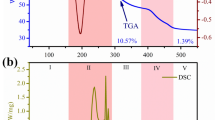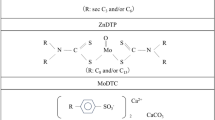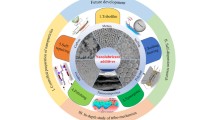Abstract
Superhydrophobic surfaces (SHS) and slippery lubricant-infused porous surfaces (SLIPS) attract great attention due to their multiple properties in both industries and our daily lives. Here, we first fabricated the SHS with micro-scale flower-like structures composed of nano-sheets on pipeline steel substrate. Then, we obtained the SLIPS by spin-coating lubricant into gaps of micro-scale flower-like structures, with the air still trapped among gaps of nano-sheets. The SLIPS shows excellent liquid repellency as the SHS. The SLIPS also shows stability after the scour of flowing water. These results of polarization curves (Tafel) and electrochemical impedance spectroscopies deduced the SLIPS with better and more stable anti-corrosion property than the SHS. Compared with the SHS, the lack of attachment and CaCO3 on the SLIPS indicates that the SLIPS demonstrates better anti-fouling and anti-scaling properties than the SHS. Moreover, the SLIPS shows promising wear resistance under the abrasion simulated by sandpaper compared with the SHS. Notably, the air trapped among nano-sheets is conducive to the lubricant flowing to the surface quickly, exhibiting spontaneous self-healing in atmosphere, even if part flower-like structures of the SLIPS subject to damage with the lubricant consumed after scratched.











Similar content being viewed by others
Data Availability
All data generated or analyzed during this study are included in this published article (and its supplementary information files).
References
Wong, T. S., Kang, S. H., Tang, S. K., Smythe, E. J., Hatton, B. D., Grinthal, A., & Aizenberg, J. (2011). Bioinspired self-repairing slippery surfaces with pressure-stable omniphobicity. Nature, 477, 443–447.
Signorelli, F., Sousa, M. F. B., & Bertran, C. A. (2019). Interfacial phenomena on the inorganic scaling prevention. ACS Omega, 4, 79–85.
Wang, Y. J., Zhao, W. J., Wu, W. T., Wang, C. T., Wu, X. D., & Xue, Q. J. (2018). Fabricating bionic ultraslippery surface on titanium alloys with excellent fouling-resistant performance. ACS Applied Bio Materials, 2, 155–162.
Niu, A. J., Bi, Z. Y., Niu, H., Huang, X. H., & Ren, Y. F. (2016). Corrosion resistance of X70LSAW pipe with heavy wall used for oil and gas transportation in deep sea. Corros Prot, 10, 12–15.
Feng, Y., & Cheng, Y. F. (2017). An intelligent coating doped with inhibitor-encapsulated nanocontainers for corrosion protection of pipeline steel. Chemical Engineering Journal, 315, 537–551.
Fan, L., Reis, S. T., Chen, G., & Koenigstein, M. (2018). Corrosion resistance of pipeline steel with damaged enamel coating and cathodic protection. Coatings, 8, 185–197.
Legg, M., Yücel, M. K., Garcia, C. I., Kappatos, V., Selcuk, C., & Gan, T. H. (2015). Acoustic methods for biofouling control: A review. Ocean Engineering, 103, 237–247.
Su, X., Hao, D. Z., Li, Z. N., Guo, X. L., & Jiang, L. (2019). Design of hierarchical comb hydrophilic polymer brush (HCHPB) surfaces inspired by fish mucus for anti-biofouling. J Mater Chem B, 7, 1322–1332.
Dafforn, K. A., Lewis, J. A., & Johnston, E. L. (2011). Antifouling strategies: History and regulation, ecological impacts and mitigation. Marine Pollution Bulletin, 62, 453–465.
Fink, J. K. (2013). Hydraulic fracturing chemicals and fluids technology. Gulf Prof Publ, 21, 234–235.
Martinod, A., Euvrard, M., Foissy, A., & Neville, A. (2008). Progressing the understanding of chemical inhibition of mineral scale by green inhibitors. Desalination, 220, 345–352.
Barthlott, W., & Neinhuis, C. (1997). Purity of the sacred lotus, or escape from contamination in biological surfaces. Planta, 202, 1–8.
Li, H., Yu, S. Y., Hu, J. H., & Yin, X. L. (2019). Modifier-free fabrication of durable superhydrophobic electrodeposited Cu–Zn coating on steel substrate with self-cleaning, anti-corrosion and anti-scaling properties. Applied Surface Science, 481, 872–882.
Yang, Z., Liu, X. P., & Tian, Y. L. (2019). Hybrid laser ablation and chemical modification for fast fabrication of bio-inspired super-hydrophobic surface with excellent self-cleaning, stability and corrosion resistance. Journal of Bionic Engineering, 16, 13–26.
Liu, X. H., Wang, P., Zhang, D., & Chen, X. T. (2021). Atmospheric corrosion protection performance and mechanism of super-hydrophobic surface based on coalescence-induced droplet self-jumping behavior. ACS Appl Mater Interfac, 13, 25438–25450.
Hwang, G. B., Page, K., Patir, A., Nair, S. P., Allan, E., & Parkin, I. P. (2018). The anti-biofouling properties of superhydrophobic surfaces are short-lived. ACS Nano, 12, 6050–6058.
Yan, H., Wu, Q. S., Yu, C. M., Zhao, T. Y., & Liu, M. J. (2020). Recent progress of biomimetic antifouling surfaces in marine. Adv Mater Interfac, 7, 2000966.
Li, H., Xin, L., Zhang, K., Yin, X. L., & Yu, S. R. (2022). Fluorine-free fabrication of robust self-cleaning and anti-corrosion superhydrophobic coating with photocatalytic function for enhanced anti-biofouling property. Surface & Coatings Technology, 438, 128406.
Jiang, W., He, J., Xiao, F., Yuan, S. J., Lu, H., & Liang, B. (2015). Preparation and antiscaling application of superhydrophobic anodized CuO nanowire surfaces. Industrial and Engineering Chemistry Research, 54, 6874–6883.
Chatterjee, R., Beysens, D., & Anand, S. (2019). Delaying ice and frost formation using phase-switching liquids. Advanced Materials, 31, 1807812.
Bohn, H. F., & Federle, W. (2004). Insect aquaplaning: Nepenthes pitcher plants capture prey with the peristome, a fully wettable water-lubricated anisotropic surface. Proceedings of the National academy of Sciences of the United States of America, 101, 14138–14143.
Jiang, D., Xia, X. C., Hou, J., Cai, G. Y., Zhang, X. X., & Dong, Z. H. (2019). A novel coating system with self-reparable slippery surface and active corrosion inhibition for reliable protection of Mg alloy. Chemical Engineering Journal, 373, 285–297.
Huang, J. F., Kang, J. J., Zhang, J. X., Huang, J. X., & Guo, Z. G. (2022). Slippery surface with petal-like structure for protecting Al alloy: Anti-corrosion, anti-fouling and anti-icing. Journal of Bionic Engineering, 19, 83–91.
Li, H., Feng, X. L., Peng, Y. J., & Zeng, R. C. (2020). Durable lubricant-infused coating on a magnesium alloy substrate with anti-biofouling and anti-corrosion properties and excellent thermally assisted healing ability. Nanoscale, 12, 7700–7711.
Xu, F. C., Li, X., Weng, D. H., Li, Y., & Sun, J. Q. (2019). Transparent antismudge coatings with thermally assisted healing ability. J Mater Chem A, 7, 2812–2820.
Cui, J. X., Daniel, D., Grinthal, A., Lin, K. X., & Aizenberg, J. (2015). Dynamic polymer systems with self-regulated secretion for the control of surface properties and material healing. Nature Materials, 14, 790–795.
Fang, Y., Chen, F., Hou, X., Huo, J. L., Yong, J. L., Zhang, J. Z., & Yang, Q. (2017). Nepenthes inspired design of self-repairing omniphobic slippery liquid infused porous surface (slips) by femtosecond laser direct writing. Adv Mater Interfac, 4, 1700552.
Yamamoto, M., Nishikawa, N., Mayama, H., Nonomura, Y., Yokojima, S., Nakamura, S., & Uchida, K. (2015). Theoretical explanation of the lotus effect: Superhydrophobic property changes by removal of nanostructures from the surface of a lotus leaf. Langmuir, 31, 7355–7363.
Han, K. Y., Heng, L. P., Zhang, Y. Q., Liu, Y., & Jiang, L. (2018). Slippery surface based on photoelectric responsive nanoporous composites with optimal wettability region for droplets’ multifunctional manipulation. Advancement of Science, 1801231, 1–8.
Bhushan, B., & Jung, Y. C. (2011). Natural and biomimetic artificial surfaces for superhydrophobicity, self-cleaning, low adhesion, and drag reduction. Progress in Materials Science, 56, 1–108.
Teisala, H., Geyer, F., Haapanen, J., Juuti, P., Makela, J. M., Vollmer, D., & Butt, H. J. (2018). Ultrafast processing of hierarchical nanotexture for a transparent superamphiphobic coating with extremely low roll-off angle and high impalement pressure. Advanced Materials, 30, 1706529.
Liu, H. L., & Cao, G. X. (2016). Effectiveness of the Young-Laplace equation at nanoscale. Science and Reports, 6, 23936.
Desai, M. A., & Sartale, S. D. (2015). Facile soft solution route to engineer hierarchical morphologies of ZnO nanostructures. Crystal Growth & Design, 15, 4813–4820.
Li, J., Liu, X. H., Ye, Y. P., Zhou, H. D., & Chen, J. M. (2011). Fabrication of superhydrophobic CuO surfaces with tunable water adhesion. Journal of Physical Chemistry C, 115, 4726–4729.
Zhou, L. L., Xu, S. Y., Zhang, G. L., Cai, D. Q., & Wu, Z. Y. (2016). A facile approach to fabricate self-cleaning paint. Applied Clay Science, 132, 290–295.
Zhou, H. M., Chen, R. R., Liu, Q., Liu, J. Y., Yu, J., Wang, C., Zhang, M. L., Liu, P. L., & Wang, J. (2019). Fabrication of ZnO/epoxy resin superhydrophobic coating on AZ31 magnesium alloy. Chemical Engineering Journal, 368, 261–272.
Zhang, M. L., Zhao, M. W., Chen, R. R., Liu, J. Y., Liu, Q., Yu, J., Li, R. M., Liu, P. L., & Wang, J. (2019). Fabrication of the pod-like KCC-1/TiO2 superhydrophobic surface on AZ31 Mg alloy with stability and photocatalytic property. Applied Surface Science, 499, 143933.
Zang, J. F., Ryu, S., Pugno, N., Wang, Q. M., Tu, Q., Buehler, M. J., & Zhao, X. H. (2013). Multifunctionality and control of the crumpling and unfolding of large-area graphene. Nature Materials, 12, 321–325.
Cassie, A. B. D., & Baxter, S. (1944). Wettability of porous surfaces. Transactions of the Faraday Society, 40, 546–551.
Liu, Y. Y., Wang, X., & Feng, S. Y. (2019). Nonflammable and magnetic sponge decorated with polydimethylsiloxane brush for multitasking and highly efficient oil–water separation. Advanced Functional Materials, 29, 1902488.
Vazquez, G., Alvarez, E., & Navaza, J. M. (1995). Surface tension of alcohol water + water from 20 to 50. degree. Journal of Chemical and Engineering Data, 40, 611–614.
Lee, C., Kim, H., & Nam, Y. (2014). Drop impact dynamics on oil-infused nanostructured surfaces. Langmuir, 30, 8400–8407.
Li, H., & Zhang, K. (2019). Dynamic behavior of water droplets impacting on the superhydrophobic surface: Both experimental study and molecular dynamics simulation study. Applied Surface Science, 498, 143793.
Chen, L. Q., Xiao, Z. Y., Chan, P. C. H., Lee, Y. K., & Li, Z. G. (2011). A comparative study of droplet impact dynamics on a dual-scaled superhydrophobic surface and lotus leaf. Applied Surface Science, 257, 8857–8863.
Aria, A. I., & Gharib, M. (2014). Physicochemical characteristics and droplet impact dynamics of superhydrophobic carbon nanotube arrays. Langmuir, 30, 6780–6790.
Baek, S., & Yong, K. (2020). Impact dynamics on SLIPS: Effects of liquid droplet’s surface tension and viscosity. Applied Surface Science, 506, 144689.
Muschi, M., Brudieu, B., Teisseire, J., & Sauret, A. (2018). Drop impact dynamics on slippery liquid-infused porous surfaces: Influence of oil thickness. Soft Matter, 14, 1100–1107.
Jiang, J. K., Zhang, H. D., He, W. Q., Li, T. Z., Li, H. L., Liu, P., Liu, M. J., Wang, Z. Y., Wang, Z. K., & Yao, X. (2017). Adhesion of microdroplets on water-repellent surfaces toward the prevention of surface fouling and pathogen spreading by respiratory droplets. ACS Appl Mater Interfac, 9, 6599–6608.
Deng, R., Shen, T., Chen, H. L., Lu, J. X., Yang, H. C., & Li, W. H. (2020). Slippery liquid-infused porous surfaces (SLIPSs): A perfect solution to both marine fouling and corrosion? J Mater Chem A, 8, 7536–7547.
Wei, D. S., Wang, J. G., Liu, Y., Wang, D. W., Li, S. Y., & Wang, H. Y. (2021). Controllable superhydrophobic surfaces with tunable adhesion on Mg alloys by a simple etching method and its corrosion inhibition performance. Chemical Engineering Journal, 404, 126444.
Wang, P., Li, T. P., & Zhang, D. (2017). Fabrication of non-wetting surfaces on zinc surface as corrosion barrier. Corrosion Science, 128, 110–119.
Zhang, X. G., Liu, Z. J., Li, Y., Wang, C. J., Zhu, Y. J., Wang, H. Y., & Wang, J. T. (2019). Robust superhydrophobic epoxy composite coating prepared by dual interfacial enhancement. Chemical Engineering Journal, 371, 276–285.
Cheong, W. C., Gaskell, P. H., & Neville, A. (2013). Substrate effect on surface adhesion/crystallisation of calcium carbonate. Journal of Crystal Growth, 363, 7–21.
Nosonovsky, M. (2011). Slippery when wetted. Nature Materials, 477, 412–413.
Su, C. L., Horseman, T., Cao, H. B., Christie, K., Li, Y. P., & Lin, S. H. (2019). Robust superhydrophobic membrane for membrane distillation with excellent scaling resistance. Environmental Science and Technology, 53, 11801–11809.
Diao, Y., Myerson, A. S., Hatton, T. A., & Trout, B. L. (2011). Surface design for controlled crystallization: The role of surface chemistry and nanoscale pores in heterogeneous nucleation. Langmuir, 27, 324–5334.
Linnikov, O. D. (1999). Investigation of the initial period of sulphate scale formation part 1. Kinetics and mechanism of calcium sulphate surface nucleation at its crystallization on a heat-exchange surface. Desalination, 122, 1–14.
Charpentier, T. V., Neville, A., Baudin, S., Smith, M. J., Euvrard, M., Bell, A., Wang, C., & Barker, R. (2015). Liquid infused porous surfaces for mineral fouling mitigation. J Colloid Interfac Sci, 444, 81–86.
Wang, W., He, Y. Y., Zhao, J., Mao, J. Y., Hu, Y. T., & Luo, J. B. (2020). Optimization of groove texture profile to improve hydrodynamic lubrication performance: Theory and experiments. Friction, 8, 83–94.
Luo, J. B., & Zhou, X. (2020). Superlubricitive engineering-future industry nearly getting rid of wear and frictional energy consumption. Friction, 8, 643–665.
Gao, X. Y., & Guo, Z. G. (2018). Mechanical stability, corrosion resistance of superhydrophobic steel and repairable durability of its slippery surface. J Colloid Interfac Sci, 512, 239–248.
Cui, M. M., Wang, B., & Wang, Z. K. (2019). Nature-inspired strategy for anticorrosion. Advanced Engineering Materials, 21, 1801379.
Acknowledgements
This work was supported by the Shandong Provincial Natural Science Foundation (ZR2019BEM012), National Natural Science Foundation of China (51905315), the Fundamental Research Funds for the Central Universities (20CX02316A), and the Opening Fund of National Engineering Laboratory of Offshore Geophysical and Exploration Equipment.
Author information
Authors and Affiliations
Corresponding author
Ethics declarations
Conflict of Interest
The authors declare that they have no known competing financial interests or personal relationships that could have appeared to influence the work reported in this paper.
Additional information
Publisher's Note
Springer Nature remains neutral with regard to jurisdictional claims in published maps and institutional affiliations.
Supplementary Information
Below is the link to the electronic supplementary material.
42235_2022_220_MOESM1_ESM.docx
Supplementary file1 Three-dimensional images of SHS and SLIPS (Fig. S1); XRD patterns and FTIR spectra of the steel sample under different conditions (Fig. S2); Photos, contact and rolling (or sliding) angles of droplets with different surface tension on SHS and SLIPS (Fig. S3); Contact and sliding angles of water and glycerol droplets on the SLIPS after scour of the flowing water (Fig. S4); Time-lapse images of water drops impinging on SHS and SLIPS with different velocities (Fig. S5); Changes of water and glycerol contact angle on the SHS and the SLIPS after immersed into 3.5 wt.% NaCl solution and seawater for different times (Fig. S6); Schematic illustration of the anti-corrosion mechanism of SHS and SLIPS (Fig. S7); Mechanisms illustration for anti-scaling of SHS and SLIPS (Fig. S8); Contact and sliding behaviors of water on SLIPS after slight and seriously knife scratch test, and the seriously scratched SLIPS after 12 h spontaneous self-healing process (Fig. S9); Electrochemical parameters of the polarization curves shown in Fig. 6(a) and (b) ; (Table S1); Charge transfer resistance (Rct) of the Nyquist plots shown in Fig. 6(c) and (d) (Table S2) (DOCX 5940 kb)
Supplementary file2 Video 1a. The water droplet is rolling on SHS (AVI 2864 kb)
Supplementary file3 Video 1b. The water droplet is sliding on SLIPS (AVI 12728 kb)
Supplementary file4 Video 2. SLIPS processed by flowing water (AVI 4302 kb)
Supplementary file5 Video 3a. Water droplets cleaned the dust particles on SHS (AVI 48713 kb)
Supplementary file6 Video 3b. Water droplets cleaned the dust particles on SLIPS (MP4 21994 kb)
Supplementary file7 Video 4a. The sliding behavior of water droplets on SHS after scratched (AVI 5566 kb)
Supplementary file8 Video 4b. The sliding behavior of glycerol droplets on SHS after scratched (AVI 14457 kb)
Supplementary file9 Video 5a. The sliding behavior of water droplets on SLIPS after scratched (100 g) (AVI 17636 kb)
Supplementary file10 Video 5b. The sliding behavior of glycerol droplets on SLIPS after scratched (100 g) (AVI 4468 kb)
Supplementary file11 Video 6a. The sliding behavior of water droplets on SHS after scratched (200 g) (AVI 8262 kb)
Supplementary file12 Video 6b. The sliding behavior of water droplets on SLIPS after scratched (200 g) (MP4 1848 kb)
Supplementary file13 Video 7a. The sliding behavior of water droplets on SLIPS after slight knife scratch (MP4 4321 kb)
Supplementary file14 Video 7b. The sliding behavior of water droplets on SLIPS after seriously knife scratch (MP4 13612 kb)
Supplementary file15 Video 7c. The sliding behavior of water droplets on seriously scratched SLIPS after 12 h spontaneous self-healing process (MP4 4538 kb)
Rights and permissions
About this article
Cite this article
Li, H., Peng, Y., Zhang, K. et al. Spontaneous Self-healing Bio-inspired Lubricant-infused Coating on Pipeline Steel Substrate with Reinforcing Anti-corrosion, Anti-fouling, and Anti-scaling Properties. J Bionic Eng 19, 1601–1614 (2022). https://doi.org/10.1007/s42235-022-00220-1
Received:
Revised:
Accepted:
Published:
Issue Date:
DOI: https://doi.org/10.1007/s42235-022-00220-1




